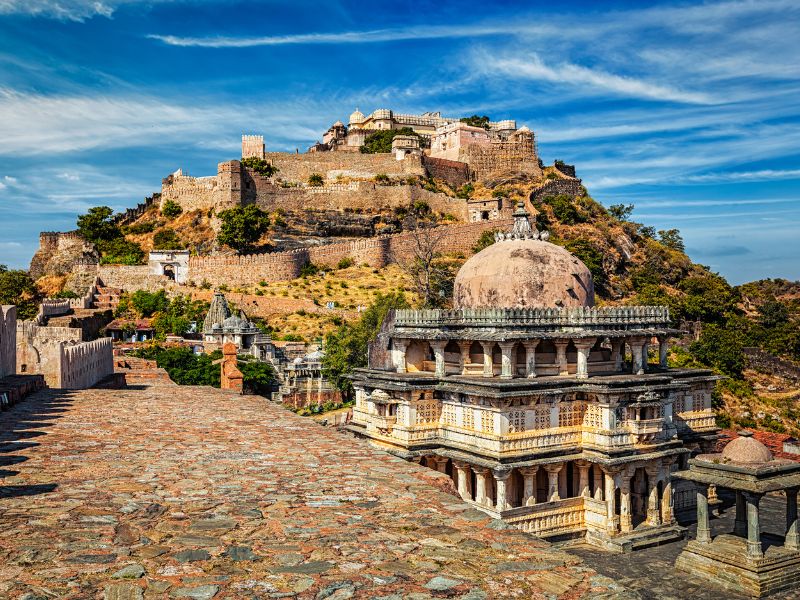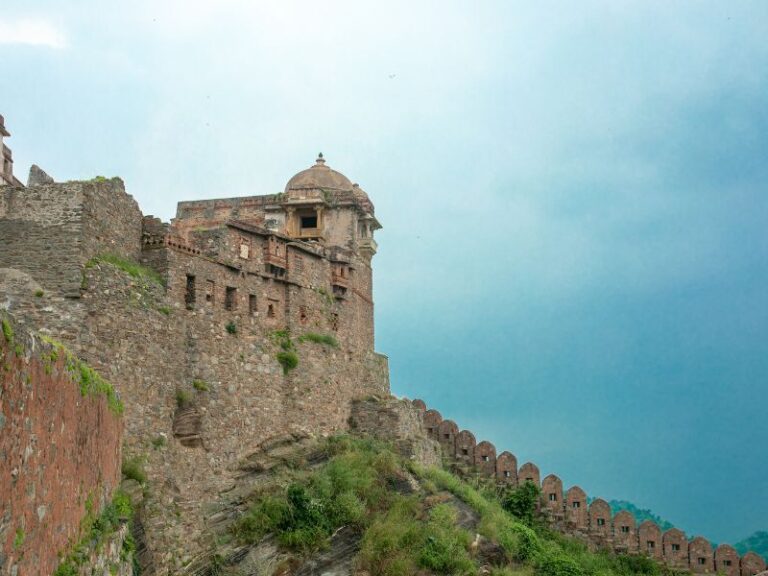Kumbhalgarh is an outstanding tourist attraction in Rajasthan. It contains all of the attractions that make Rajasthan so appealing to tourists, including temples, forts, and the remnants of former military strongholds, as well as the odd shopping mall. The fact that it comprises World Heritage Sites is an extra benefit, demonstrating how deserving of praise it truly is in terms of history, architecture, culture, and other factors. Who doesn’t appreciate a good vantage point? The region of Kumbhalgarh extends quite into and surrounding the Aravalli Hills as well, with important locations situated there. No one. However, avoid going during the hottest months of the year and please stick around as we list the top 5 tourist spots on Kumbhalgarh.
1. Kumbhalgarh Fort


The Kumbhalgarh fort in Rajasthan is the fort that has established itself as having the second-largest wall after the Great Wall of China. The powerful fort that encircles Udaipur is 38 km long and 3600 ft tall. Rana Kumbha was thought to have constructed it in the fifteenth century. The fort has also been named a UNESCO World Heritage Site, falling under the category of Rajasthani Hill Forts. On the western Aravalli hills, at a beautiful location.
The hill acts as the impenetrable border because it has seen many conflicts. The fort, which has many Jain temples and seven defensive entrances, as well as the Lakhola Tank is the most well-known tank inside the fort, which Rana Lakha built. The fort is home to a variety of Hindu and Jain temples that reflect the monarchs’ tolerance of other religions as well as how they supported the Jains and promoted their culture inside the realm. Kumbhalgarh Fort is an absolute sight in the sun, and it makes for a great photo opportunity. The fact that it was instrumental in obtaining the UNESCO heritage status is evidence of its value. It is Mewar in fortification and was constructed by Rana Kumbha over four centuries. It hosts light displays at night and has influenced much of the nation’s folk literature.In lieu of the sweltering heat of the summer, which lasts from March to June, the ideal time to visit the fort is during the winter between the months of October and February, when the climate is calmer and suited for people.
2. Badal Mahal
Do you believe a building would be more stunning if its name was “Mansion in the Clouds”? Considering that this one is just that. Regarding aesthetic value and architectural quality, it is both beautiful and pleasing. Due to its height, Badal Mahal, which is a part of the fort’s main body, offers views of the mountains, urban life, and everything else in a very broad range from its hilltop perch in the clouds, both metaphorically and literally. Its two divisions are Zanana for females and Mardana, the masculine gender’s literal name, for males. The Kumbhalgarh Fort’s highest peak is Badal Mahal. renowned for being the “Palace of Clouds.” It may be found atop the Kumbhalgarh Fort. The palace Badal Mahal has two stories. The Mardana Mahal and the Zanana Mahal are two linked mahals that make up the entire palace structure. The chambers at Badal Mahal are beautifully painted and have paintings in pastel colours that depict the era of the nineteenth century. Place rooms have walls painted in turquoise, green, and white.In the Zanana Mahal, there are stone jalis that the queens once used to see the court hearings and other important events.It’s fascinating that these rooms feature a unique air conditioning system.
3. Neelkanth Mahadev Temple


The Neelkanth Mahadev Temple, built in traditional Rajasthani fashion, is also a component of the Kumbhalgarh chieftain’s fort complex. When seen from specific angles in the dark, it turns white in colour and provides for lovely photos. It contains a 6-foot lingam within, one of the few that is really looked for by local modern humans, and is dedicated to Lord Shiva. When you’re in the neighbourhood, make plans to pay a visit on a sightseeing trip because this is highly important from a tourist standpoint. Visitors from all over the globe have been drawn to the holy Ganges, which flows through Rishikesh, nurturing and caring like a mother, and the solid Himalayas, which guard the little and sacred hill station like a responsible father. The story of some of the most important events in Hindu mythology is told through the trance and enchantment of this mystical city. The Neelkantha Mahadev Temple in Rishikesh, which is venerated by visitors from all over the world and is one of the most frequented pilgrimage sites since ancient times, comes in first place on our list. Therefore, skipping this historic temple when visiting this area is completely out of the question.
4: Kumbhalgarh Wildlife Sanctuary


In the Rajasthani district of Rajsamand sits the Kumbhalgarh Wildlife Sanctuary. It encircles portions of Udaipur, Rajsamand, and Pali, reaching across the Aravalli mountains and covering a total area of 578 sq km. The historic Kumbhalgarh Fort is located inside the boundaries of the wildlife sanctuary, which has the same name. Those who think of Rajasthan as a desert state will undoubtedly be pleasantly surprised by this steep, lush forest near Kumbhalgarh. Mewar and Marwar, the two distinct regions of Rajasthan, are separated by the park’s lush area.
The Sanctuary’s current location was formerly a royal hunting preserve before being transformed into what it is now in 1971. The sanctuary’s other allure is that it is the geography, which it claims of being diversified. The Aravalli mountains, which rise 3,748 feet above sea level, border the eastern portion. The main source of water for the sanctuary is the River Banas, which also blesses it.
A 40-strong wolf pack, which is uncommon to find elsewhere, makes Kumbhalgarh Wildlife Sanctuary notable. In addition to the wolf, it is home to about 200 distinct bird species and several endangered and uncommon animal species. The Kumbhalgarh Wildlife Sanctuary’s gorgeous vegetation is brought on by the monsoon, and the fall brings out its russet tones. The refuge also provides space for additional activities including jeep safaris, horseback safaris, and trekking. There are also a large number of tribal members of Garasia and Bhils living in their primitive cottages. Visitors come to the refuge from all around because of its natural beauty.
Who would have known, well? It turns out that Kumbhalgarh is not just a collection of dead rocks and sticks. in addition to palaces, forts, and temples. Kumbhalgarh Wildlife Sanctuary, a popular tourist site, is home to several cute animal species. And given that this sanctuary has the difficult to locate sloth bear in its archives, it appears to be the season of unusual findings. That is just as uncommon as some of the nearby historical specimens.
Kumbhalgarh is a fascinating and entertaining tourist destination in Rajasthan, India. You may visit temples to reconnect with your spirit and find renewal, or you can stroll around hilltop forts to become lost in the past.

